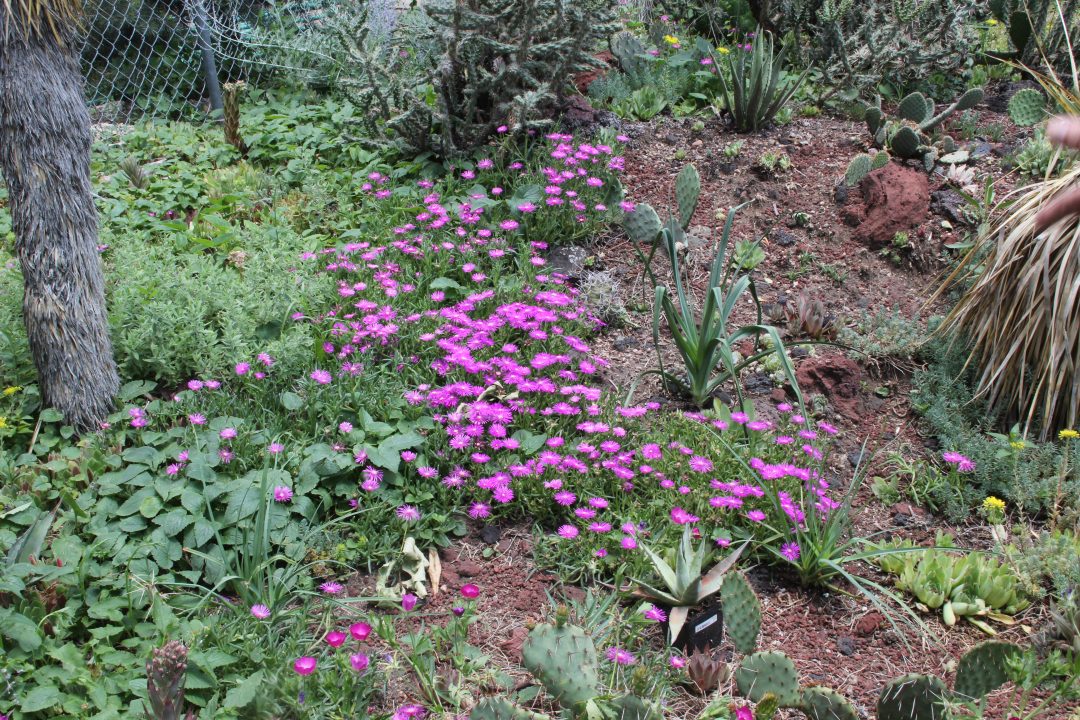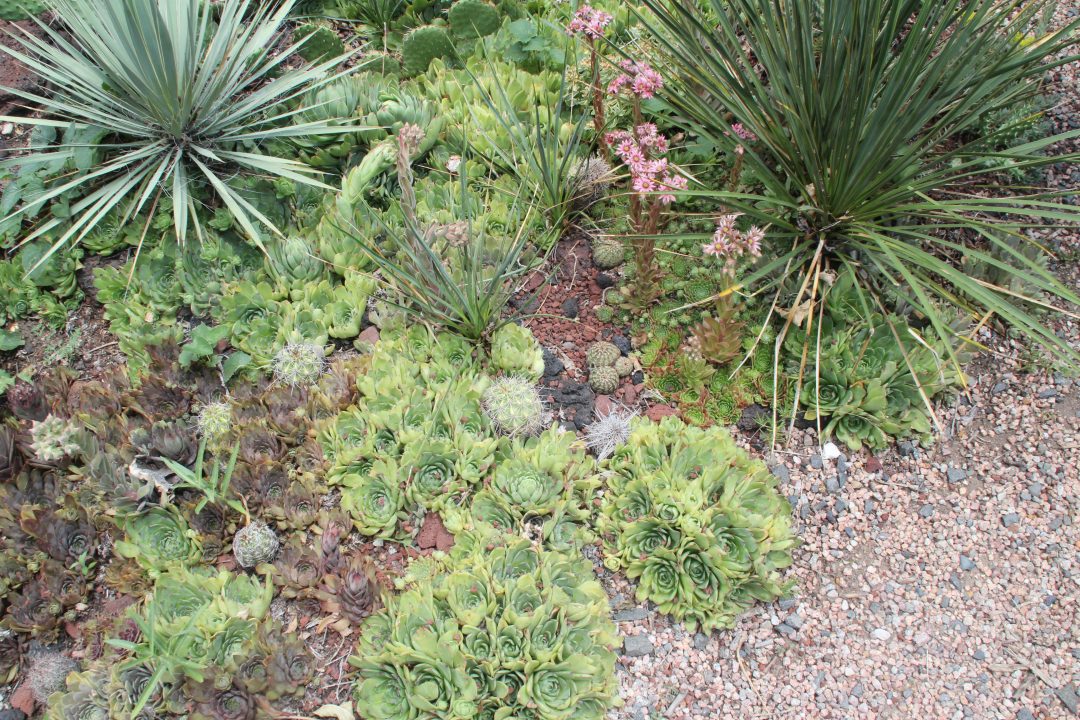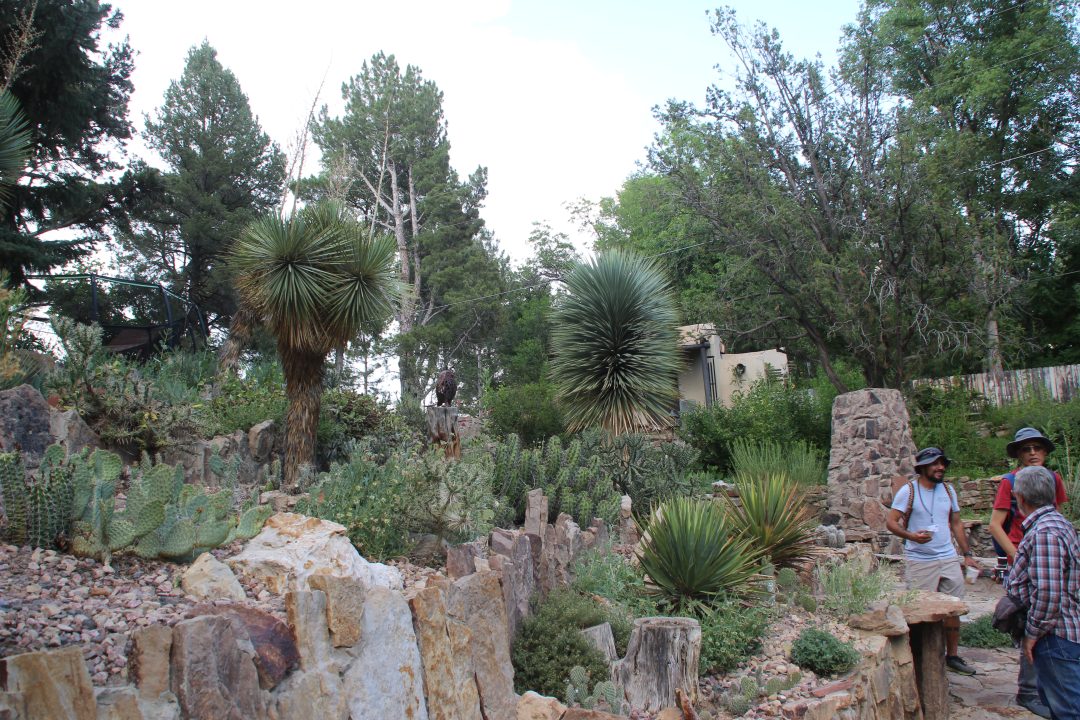The Cactus and Succulent Society of America (CSSA) held its biennial convention in Colorado Springs this year. Here’s how it went.
I arrived July 12 at the Colorado Springs Marriott to register and get settled in.
I met up with members from the Austin Cactus and Succulent Society that made the trip, too, and we had supper together while discussing the tours we chose to take tomorrow and a variety of cactus-related topics, something we cactus lovers tend to do.
My tour involved visiting three local gardens by bus. Which would have been fine, had the air conditioner on the bus worked! We wound up sitting in a friendly Panera Breads cafe talking cactus for over an hour waiting for the new bus with the working air conditioner and eventually made it to the gardens, the purpose of which was to see what grows in the Colorado Springs climate and altitude that might grow in our gardens at home.
Leo Chance’s garden in Colorado Springs had many plants that I grow in my garden, but perhaps a bit lusher here due to the cooler climate and difference in rainfall.
Jeff Thompson’s Stoney Creek Cactus in Pueblo was more spread out around his yard, and he also had two large greenhouses full of plants that he sells wholesale.
The crown jewel of the tour, however, was the last house we visited, the home of Dr. Andrew and Michelle Conrad, also in Pueblo. The house was a Santa Fe-style home, inviting from the front.
But the back-well, it could have been a public botanical garden! I don’t know the history of it, but I think a lot of the stonework had been there before the house, and it was something to behold. And one picture doesn’t do it justice, but if I put them all in, it would be a story on its own. This is just a small part of the whole thing; we were all salivating, wishing we had something like this in our back yard!
Back at the hotel, the last event of that day was a welcome reception with hors d’oeuvres and a raffle for tickets to get first choice in the sale tent before everyone else gets to go in. Unfortunately, my ticket was not a winner, but I did go in after the winners had time to get their first pick of the plants and pots on sale. Needless to say, I made several trips out to the sale tent during the convention, but didn’t buy but three plants. Some people were hauling out box loads of plants!
For the next three days we had presentations given by a variety of cactus experts on a variety of topics. I always sit in the front row, or in this case, at one of the front tables, so I can take pictures of the slides from the presentations. I learned long ago trying to take notes was futile because I couldn’t keep up! And I could give you a play-by-play of a boatload of slides, but to really appreciate them you had to see for yourself. So, instead I will mention some of the things I learned and show you perhaps a taste of what these speakers shared with us; back row: Karen Ostler, Ernst Van Jaarseveld, Kelly Grummons, Stefan Burger, Marcia Tatroe, Donnie Barnett, Woody Minnich, Rod Haenni; middle row: Gunnar Eisel, Elisabet Sarnes; kneeling: Ernesto Sandoval, Rob Wallace, Peter Breslin, Panayoti Kelaidis. Not pictured: Don Barnett,
Oh dear. I made a list of those things that I learned that I said I would share with you-well, I wound up with a three page list! So I made myself choose the three or four things I learned that might be helpful to you. Okay, five. But I think they are important; you may not. But to really take proper care of your plants, at least check out these topics.
Plant metabolism is based on photosynthesis, and photosynthesis occurs with light, and cactus and succulents need lots of light. That’s the simplified version, and to learn the scientific version is why I go to these talks, so the main point here is give your plants sunshine. Lack of good sunlight is nearly always the problem when people tell me about their ailing plant, and I know this without going to the convention, but it came up again and again during the presentations. When cactus look like the ones in the image below, lack of light is the problem. When succulents get leggy and ugly, that’s the same problem. It is called etiolation. Moving the plant to a sunnier location with dappled sunlight or in some cases, full sunlight, will do it a world of good. I will have to caution you that sometimes when the damage is to this point, even good light won’t restore the growth pattern on a cactus, but usually it will. After succulents that have become leggy are pruned back, they, too, will respond. Always make the cut right above two leaves on the stem.
Air circulation is important and often overlooked, especially in greenhouses and succulents suffering indoors. Good air flow helps keeps down bugs. Winter in my greenhouse is always when I have mealy bug problems, never in the warm months when the plants are outside. And something I had not thought of before is that good air circulation provides a form of exercise for the plants! Not dust storm winds, mind you, but you get the idea.
I have been aware of root hairs, but have learned more about their importance and the need to keep them viable in potted specimens. So you don’t want to neglect watering to the point that those root hairs wither and die and new ones have to start over growing. Also, don’t burn root hairs and other roots by feeding your plants when the soil has been bone dry for a long period of time. Water once before feeding to get the soil a bit damp for the fertilizer. And it was suggested that using a weak feeding solution every time you water might not hurt, something I am going to try.
We have all seen cactus growing in rocks and wondered how in the world that works. Well, Australian Stefan Burger who now lives in Chile with their wonderful cactus told us! And again, the simple explanation is that it involves bacteria, enzymes, nitrogen, and root hairs that speed up the weathering process in rock. It’s all right here in his slide from the presentation. Amazing.
Once again taxonomy was discussed and Rob Wallace explained how nomenclature-the botanical naming of plants- works and encouraged us to learn our plants’ scientific names. He pointed out that we are all taxonomists in one way or the other-do you organize your silverware by type, for example? And common names aren’t real useful unless you are talking about prickly pear, maybe. That round cactus you call a barrel cactus-which one is it? A ferocactus? Notocactus? Gymnocalycium? Horizonthalonius? And the list goes on. To really understand and study your cactus, you really need to learn the names. And it isn’t that hard once you get into it and take the pronounciation one syllable at a time and practice a bit.
I will mention a few other things, like the fact I was reminded that some aloes grow to make small trees, propagation can also be done by splitting plants, Mexico has the highest diversity of native cactus, the importance of the size of soil particles and the importance of an acidic pH, and that I would love to visit Patagonia and Chile and see plants in habitat. Most of this I was already aware of, but there is so much to learn, it never hurts to hear it again. Which is why if you are serious about your cactus collection, you should become a member of CSSA and attend a convention. Then you will get to hear the long version of the scientific explanations that I shortened.
We enjoyed the rare plant auction, a banquet, and all the beautiful images of cactus and their flowers from all over the New World-I am pretty sure I have told you before that cactus are are native only to the Americas. Succulent plants can be found all over the world, but cacti, which are succulent plants, are only indigenous to this part of the world.
I will leave you with a few pictures of some of the beautiful and unusual cactus and their flowers we saw in the presentations:
Okay, so this last one is a succulent, not a cactus, but isn’t it lovely?
The next convention will be in 2025 in Burbank, California. You really need to consider it. At least join CSSA and think about it. It will be a heck of a road trip and who knows what else you may learn about the most underrated plant group on the planet.
What a deal!






















Recent Comments